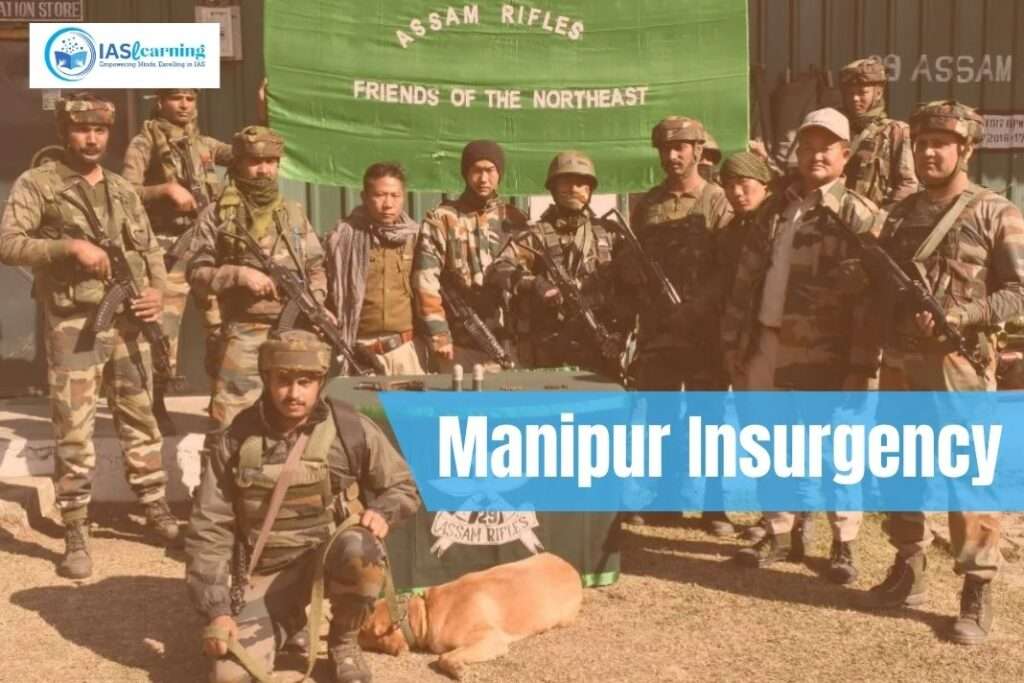Introduction to Manipur Violence
The emergence of Manipur Violence dates back to 1964 with the formation of the United National Liberation Front (UNLF), which still remains one of the formidable militant outfits
Rise of insurgency in Manipur
- The rise of separatist insurgency in Manipur mainly attributed to perceived discontent over alleged “forced” merger of Manipur with the Union of India and the subsequent delay in granting it full-fledged statehood. While the erstwhile Kingdom of Manipur was merged with India on October 15, 1949, it became a state only in 1972.
- The later years saw a slew of militant outfits being formed, including the People’s Liberation Army (PLA), People’s Revolutionary Party of Kangleipak (PREPAK), Kangleipak Communist Party (KCP), and Kanglei Yawol Kanna Lup (KYKL), among others. These valley-based outfits have been demanding an independent Manipur.
- The Naga movement in neighbouring Nagaland spilled over into Manipur’s hill districts with the NSCN-IM controlling most of it while pressing for “Nagalim” (Greater Nagaland), which is perceived in the valley as a “threat” to Manipur’s “territorial integrity”.
- In 1980, the Centre declared the entire Manipur as a “disturbed area” and imposed the controversial Armed Forces Special Powers Act (AFSPA) to suppress the insurgency movement, which remains in force till date.

History of Conflict in Manipur violence
- The oldest rebel movements in India have crossed paths in Manipur.
- The longest-running insurgency in the nation, known as Naga, strives for Greater Nagaland, also known as Nagalim.
- Kuki – Kuki organizations have also engaged in conflict with the Indian government seeking the creation of a “independent Kuki homeland” in Manipur.
- Following ethnic confrontations with the Nagas of Manipur in the early 1990s, the Kuki insurgency gained traction.
- The Manipuri Meiteis also rejected the 1949 merger deal between the Manipuri king and the Indian government.
- A meitei rebel organisation called the United National Liberation Front (UNLF) was established in 1964 and demanded separation from India.
- The People’s Revolutionary Party of Kangleipak (PREPAK) and the People’s Liberation Army (PLA) were among the several Meitei insurgent (valley insurgent) organizations that afterwards emerged.
Key Insurgent Groups in manipur violence
- United Nation Liberation Front : The 1964-founded UNLF wants to create a communist independent Manipur. It is one of the state’s oldest and busiest rebel organizations.
- People’s Liberation Army (PLA) and People’s Revolutionary Party of Kangleipak (PREPAK) are two organizations that support Manipur’s separation from India. They were both created in 1978 and 1977, respectively.
- Kangleipak Communist Party (KCP): The 1980s saw the formation of the Kangleipak Communist Party (KCP), which sought to establish Manipur as an independent communist state.
- The NSCN-IM (National Socialist Council of Nagaland-Isak-Muivah) Despite having its headquarters in Nagaland, this rebel Naga organisation has had a significant impact in Manipur, particularly in regions with a Naga majority. They want the creation of a “Greater Nagaland” that includes Manipur’s Naga-populated regions.
- The Zomi Revolutionary Army (ZRA), which speaks for the Zomi ethnic group, has called for the Zomi people to have their own independent state.

Factors and Causes of Manipur Violence
Ethnic Diversity: Manipur is home to a variety of ethnic communities, each of which has its own unique cultural and social identity. Competition for resources and political influence causes tensions.
Marginalization and estrangement: The Manipuri populace has experienced emotions of estrangement as a result of historical neglect and marginalization by the central Indian government.
Lack of Development: The region’s socioeconomic underdevelopment has fostered unrest and given insurgent organizations a recruiting ground.
Boundary Disputes: Tensions between different ethnic groups, notably Meiteis and Nagas, have increased as a result of disputes over borders and territory.
Identity and Autonomy: Many rebel organizations aim to maintain their ethnic identities while gaining more freedom or independence from India.
Government reaction regarding Manipur violence
Security measures: In order to combat the insurgency, the Indian government has deployed security personnel, which has resulted in both successful operations against the rebels and accusations of human rights violations.
Peace Negotiations: To find peaceful solutions, the government has held negotiations with a number of rebel organizations throughout the years. For instance, talks to resolve Naga-related concerns have featured the NSCN-IM.
Development Initiatives: To lessen the attractiveness of insurgency among the populace, efforts have been undertaken to alleviate socioeconomic difficulties.
Challenges:
Complexity: It is difficult to come up with a complete answer due to the diversity of ethnic groups and their various needs.
Political Will: A lasting peace depends on the political will of both the rebel groups and the central authority.
External Factors: Movements across borders and the influence of nearby nations can have an impact on how the insurgency develops.
Conclusion
The Manipur violence is a complicated problem with underlying historical, racial, and socioeconomic issues, to sum up. Although attempts have been made to resolve the dispute, establishing a long-lasting peace would entail resolving differences, advancing development, and holding open discussions with all parties involved.
Read Morehttps://en.wikipedia.org/wiki/Insurgency_in_Manipur
For more Detailshttps://iaslearning.in/

